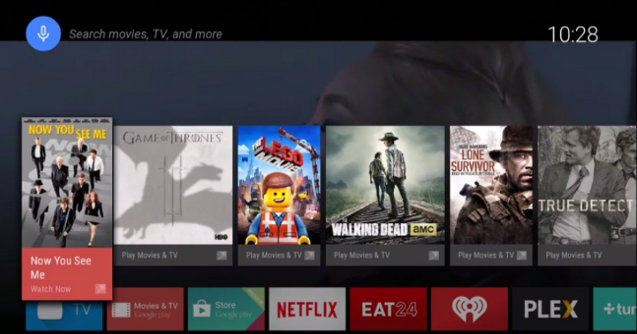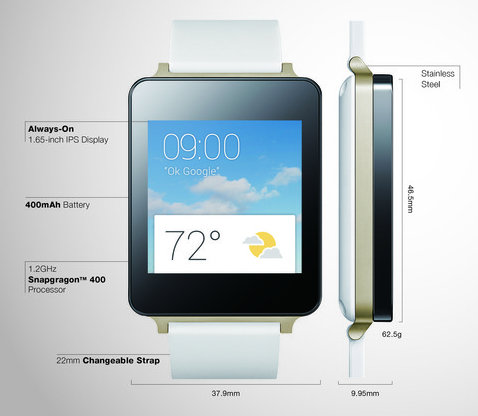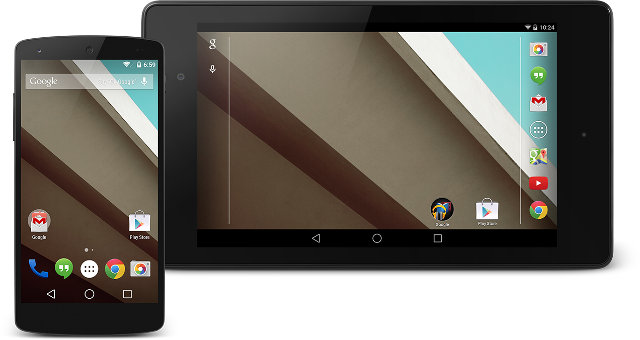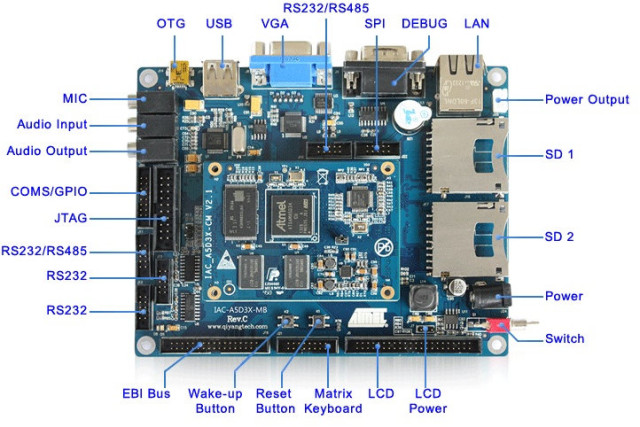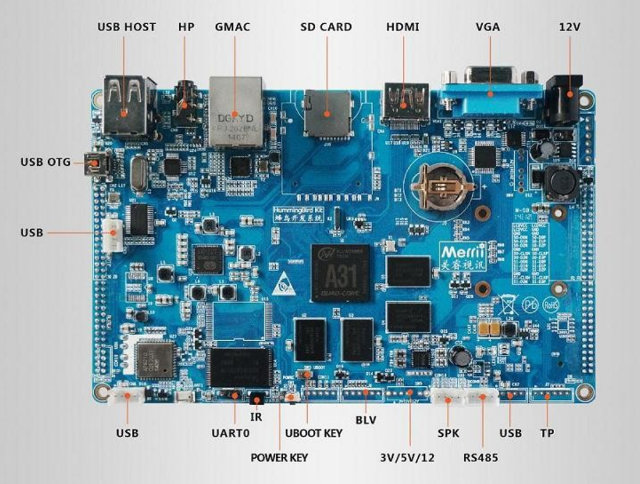After Android L for mobile devices, and Android Wear for wearables, Google also announced Android for your television at Google I/O 2014, and after definitely killing “Google TV”, renaming it to “Google Services for Smart TV”, the company went for the obvious and called it “Android TV”, which will get messy with all the Chinese “Android TV” boxes that do not run “Android TV” but simply “Android”… Google apparently used an Android TV reference platform (ADT-1) based on Nvidia Tegra 4 K1 at I/O to showcase their latest implementation of Android the the living room. I’ve embedded the video of the demo below, but the key part of the demo can be summarized as follows: Android TV’s “TV Input Framework” can overlay notifications and other data on top of various video sources such as HDMI, TV tuners, and IP TV receivers Voice control demo (with smartphone) with requests such as: […]
Google Releases Android Wear SDK, LG G Watch and Samsung Gear Live Smartwatches Are Now Available
I’ve just covered what’s new in Android L?, and I’m going to focus on Google I/O 2014’s announcements related by Android wear starting with hardware with LG G Watch ,and Samsung Gear smartwatches, followed by some details about the first official release of Android Wear SDK. LG G Watch Specifications: SoC – Qualcomm Snapdragon 400 @ 1.2 GHz System Memory – 512MB RAM Storage – 4GB eMMC Display – 1.65” IPS display (280 x 280) Connectivity – Bluetooth 4.0 LE Sensors – 9-Axis (Gyro / Accelerometer / Compass) IP Rating – IP67 dust and water resistant Battery – Li-ion 400mAh Dimensions – 37.9 x 46.5 x 9.95 mm Weight – 62.5 grams LG G watch will run Android Wear (as it’s the subject of this post), and it currently available on Google Play for $229 (US only?) with shipping scheduled for early July. Samsung Gear Live Specifications: Processor – Unnamed […]
Google Releases Android L (Lollipop?) Developer Preview
Google I/O is taking place right now in San Francisco, and the company made several announcements. Although they have not announced the full codename of Android 5.0, referring to the next version as “Android L” (Lollipop would be nice though), but they’ve already documented the key changes made to Android L, and a developer preview will be released later today (26 June), together with binary images for Google Nexus 5 and Nexus 7. Beside the smartphone and tablet developer preview, there will be 3 other SDKs for Android L: Android Wear SDK – Android for wearables with sync notifications, wearable apps, data transfer APIs, and voice actions, e.g. “Ok Google, call mum”. Android TV Preview SDK – Android for TVs with pre-built fragments for browsing and interacting with media catalogs, in-app search, and recommendations. Android Auto SDK – Android for the car with apps featuring consistent user experience between vehicles, […]
Amazon Fire Phone Features a Camera Array for Dynamic Perspectives, and Firefly Real-Life Object & Audio Recognition
Amazon first phone has been rumored for a few months, and yesterday Jeff Bezos finally unveiled the Fire Phone powered by Qualcomm Snapdragon 800 processor @ 2.2 GHz, with 2 GB of RAM, a 4.7″ 720p display. It also supports 3G and LTE cellular connectivity, and beside a 13MP rear camera, and 2MP front camera, it also features a specialized camera array with four sensors to offer “Dynamic Perspective” and show different information depending on the position of the phone. Beside the hardware, the most notable feature is Firefly an augmented reality application that can recognize objects you may want to buy, and automatically link them to the Amazon store. Let’s go through the hardware specifications first: SoC – Qualcomm Snapdragon 800 quad core CPU @ 2.2 GHz with Adreno 330 GPU System Memory – 2GB RAM Storage – 32 GB or 64 GB Display – 4.7″ HD LCD display, […]
Qiyang Technology ARM Development Boards Based on Atmel SAMA5D3, TI Sitara AM335x and Freescale i.MX6 SoCs
Hangzhou Qiyang Technology (杭州启扬智能科技有限公司) is a company based in Hangzhou, China, that provides embedded hardware solutions such as low power development boards and computer-on-modules. I’ve recently come across the company, and they have boards for various ARM based SoCs, but I’ve received details about three of their latest industrial development boards powered by Atmel SAMA5D3 Cortex A5 processor, Texas Instruments Sitara AM335x Cortex A8 SoC, and Freescale i.MX6 single and multi-core ARM Cortex A9 SoCs. Let’s have a look. Qiyang QY-A5D3XEK – Atmel SAMA5D3 Development Board The development kit is comprised of a base board (IAC-A5D3X-MB) and a computer-on-module (ICA-A5D3X_CM) with the following hardware specifications: Processor – Atmel SAMA5D3 ARM Cortex A5 @ 536 MHz (Either SAMA5D31, SAMA5D33, SAMA5D34 or SAMA5D35) System Memory – 256 MB DDR2 @ 333 MHz Storage – 256MB NAND flash + 2MB dataflash on CoM, 2x SD card slot on baseboard Video Output – VGA, […]
QNAP TS-x51 NAS Supports Up to 16 Drives, On-the fly HD Video Transcoding, HDMI Output, Virtualization and More
QNAP has introduced their latest TS-x51 NAS family at Computex 2014 with four NAS supporting between 2 to 8 drives, expandable to a total of 16 drives via expansion enclosures. The storage devices powered by an Intel Celeron J1800 dual core processor boast video transcoding capability that’s 18 times faster than earlier Atom based solutions, feature an HDMI port, and support virtualization to allow you to run two operating systems such as Linux and Windows 8. QNAP TS-x51 specifications: SoC – Intel Celeron J1800 dual core processor @ 2.41 GHz (burst frequency: 2.58) with Intel HD graphics System Memory – 1GB SO-DIMM DDR3L-1333 or 4GB SO-DIMM DDR3L-1333 (Each model listed above has 1GB or 4GB RAM options), expandable to 8GB RAM via a second RAM slot Storage 512 MB flash (DOM – Disk On Module) Hot swappable 2.5″ or 3.5″ SATA drives @ 6Gb/s, 3Gb/s. Expansion enclosures – UX-800P, or UX-500P RAID […]
First Tizen 3.0 Common Milestone Released, Developer Program Announced
The Tizen Steering Group has announced the first release of Tizen 3.0 Common. Tizen Common is the common subset of development / build / test platform of the Tizen profiles, used by platform developers to develop the next version of the profiles, and a Tizen 3.0 common release is planned every quarter. This milestone release includes: 64-bit support for both Intel and ARM architectures Crosswalk-based web runtime Multiuser support Systemd Security: three-domain rule system for SMACK and Cynara as authorization framework Wayland display server Pre-built binary releases for can be downloaded @ http://download.tizen.org/releases/daily/tizen/common/common-wayland-x86_64/tizen_20140602.26/ for Intel Atom 3815 NUC Kit and NEXCOM VTC1010 in-vehicle computer based on Intel Atom 3825. However, Tizen 3.0 Common will also be tested on Intel NUC Haswell (core i5), Lenovo x230 IvyBridge (core i5) and on the ARM side, ODROID-U3 development board. If you want to build your own, refer to the developer guide, using tizen_common_2014.Q2 tag. More details can be found […]
Hummingbird A31 Is a $70 Feature-packed Development Board Powered by AllWinner A31
Merrii Technologies introduced the Hummingbird development kit powered by AllWinner A20 last year. Since then they’ve sold 10,000 pieces, and have been working on another development board based on AllWinner A31 with lots of different ports and options, including an optional 7″ capacitive touch screen. “Quad Core” Hummingbird specifications: SoC – AllWinner A31 quad core ARM Cortex-A7 with PowerVR SGX544MP2 GPU compliant with OpenGL ES2.0, OpenCL 1.x, DX 9_3 System Memory – 1GB DDR3 Storage – 8GB Flash + micro SD card slot Video Output – HDMI, VGA, LVDS Video Input – 3.5mm jack for CVBS (or YPbPr?) In (TV IN) Audio I/O – HDMI, 3.5mm jack for stereo audio, 3.5mm jack for Line IN (Same as TV IN). 2x 15w amplifier on-board. Camera – MIPI interface Connectivity – Gigabit Ethernet, 802.11 b/g/n Wi-Fi and Bluetooth (AP6210 module) Cellular Connectivity – SIM card slot + mini PCIe connector for 3G […]


